Latest News
September 1, 2012
By Pamela J. Waterman
Just when you thought you had multiphysics (MP) analysis figured out, you got put on a project that involves collaboration across multiple disciplines—mechanical, electrical and maybe even optical. Accessing the right simulation software, tracking all possible input data, combining analysis results and connecting with databases across teams and vendors could really stress you out.
|
MP Analysis vs. Multidisciplinary Analysis Multiphysics (MP) analysis produces very detailed simulations involving forces, pressures, stresses, temperature distributions, flow rates, etc., in small gradations across often-complex geometries. Results from one simulation serve as input to another, either loosely or closely coupled. |
The good news is that traditional simulation packages are being extended—not only to help different disciplines work with the same models, but also to share the results across higher level collaborations.
Small Scale, Large Scale
Ask 10 different people the difference between MP analysis and multidisciplinary analysis, and you’ll get 10 slightly different answers.
“Working with the multiphysics aspects of a single electronic chip, for example, though complicated, is not a systems or multidisciplinary point of view,” notes Barry Christensen, ANSYS director of product marketing.
However, making sure that structural, hydraulic, electromagnetic interference (EMI) and airflow design requirements are met for an aircraft design definitely qualifies as the latter.
Managing successful multidisciplinary efforts requires a number of processes to fall into place, all among groups with different goals:
- accessibility to the appropriate simulation software;
- ability to share information and visualizations; and
- support for moving and tracking large amounts of data.
Autodesk’s Bob Williams, product marketing manager for simulation, has seen changes in all three areas, in ways that even small businesses can use. One of the biggest advances is getting away from each team having to purchase its own desktop licenses, and worrying about which revision is in use.
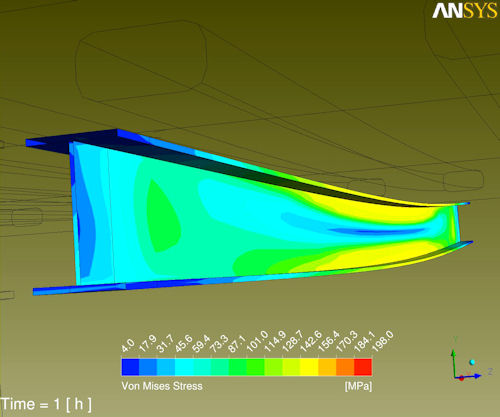 |
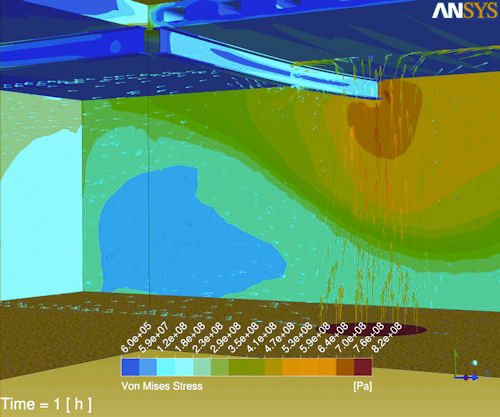 |
| Determining the effect of a room fire on ceiling beams requires the consideration of the entire system of air and heat flow, thermal radiation, heat conduction within the structures, structural deformation of the support beams, and elastoplastic material behavior. Using fluid-structure interactions modeled in ANSYS software, researchers can predict beam displacement over time. (Images courtesy ANSYS.) | |
“We have been moving toward a term-based license, as well as access to software via the cloud, turning it into an access model instead of an ownership model,” says Williams. “With just a sign-in account, you can make sure that everyone who needs access to a simulation tool has it—whether it’s a mechanical engineer, an electrical engineer, an industrial engineer or even a designer.”
Once that starts happening, Williams points out, multidisciplinary work becomes a sharing issue: “When you move from text to images to photorealistic rendering, everything that makes it easier to communicate is helpful, like report generation in simulation tools. But the significant change is using the cloud to enable even more real-time collaboration.”
Williams notes that his company’s Autodesk 360 product allows users across the world to not only share mechanical data via the cloud, but includes mobile applications so that wherever users are, they can look at simulation results, do mark-up, etc.
Regarding data management, Autodesk Vault is the company’s solution for teams to archive and update their findings, while Autodesk PLM 360 offers ways to synchronize data and add additional layers such as workflows and processes.
Altair software developers, which pioneered an on-demand licensing model, have also been putting a great deal of thought into just which kinds of multidisciplinary data need sharing, and what people do with it.
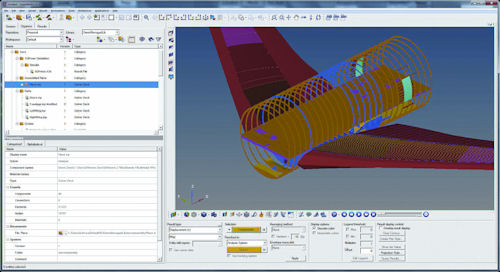 |
| Altair software lets users involved in multiple disciplines organize CAE data, access shared libraries and collaborate. (Image courtesy Altair Engineering.) |
Ira Goldstein, Altair director of HyperWorks collaboration tools, notes, for example, that users need to explore and access existing simulation information (where is the solver deck I created last year?), organize that content (how can I categorize information across teams in a consistent and repeatable manner?), and connect across broader function-groups (what other data sources come into play?).
Although product data management (PDM) software might come to mind as a solution, it was typically created simply to manage product data such as a bill of material (BOM). Goldstein voices what many engineers feel: “When we talk about data management and PDM, users typically view it as making their job harder. A top-down PDM approach presents challenges in the CAE community: It requires infrastructure, hardware and IT involvement, and is typically a long-term project with overhead. If it comes through IT, it’s suspect.”
However, with HyperWorks 11.0 embedded collaborative tools, including a new browser, the user doesn’t have to add hardware or work through another tool. Altair’s bottom-up approach allows immediate use by the desktop user, analyst, supervisor and small team. Then, as needed, HyperWorks Enterprise tools can be added for use by managers, directors and chief engineers, viewing different defined interfaces.
Product development that addresses the standard triple mantra of “faster, better, cheaper” is truly today’s norm. At ANSYS, developers believe the only way to keep pace is for engineering teams in every industry to shift from a component, or subsystem view to a higher-level systems perspective—applying multiple physics, multiple scales and a collaborative engineering approach. Christensen says teams of electrical, structural and fluids engineers must overcome their distinct functional silos to work together.
ANSYS has supported a system-level point of view for at least 10 years, starting with its Workbench Platform. Cross-functional teams can use ANSYS Workbench solvers for a variety of MP analyses, on both component- and system-level designs. And the ANSYS Engineering Knowledge Manager (EKM) tool fills the need for data back-ups, archiving, traceability and audit trails, while permitting real-time data sharing across time zones.
ANSYS recently acquired Esterel Technologies, a provider of embedded software simulation solutions for applications such as aircraft-safety systems and nuclear power-plant monitoring tools. Esterel solutions will complement ANSYS’ systems point of view by going beyond the physics to include control system software simulations. Work is under way on software links between the two.
Speeding up Development Cycles
Mentor Graphics has long been familiar with the need to look at system-level behavior. With its roots in electronic chip, package and board design, the company expanded in 2008 to include 3D heat transfer and fluid-flow capabilities based on FloEFD computational fluid dynamics (CFD) software, offering engineering fluid dynamic solutions in more than 30 industries. This electro/mechanical/thermal analysis foundation has served it well, as the company continues to expand its interfaces to dozens of other design and analysis packages.
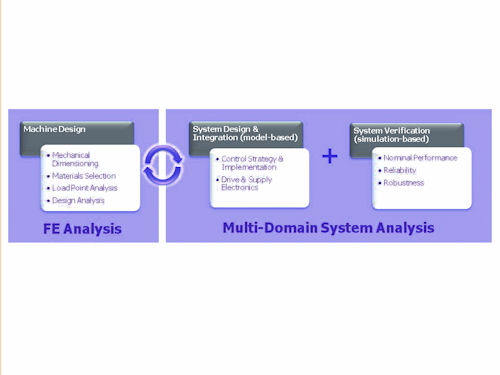 |
| An integrated design approach from Mentor Graphics bridges the gap between conducting detailed finite element analyses and engineering the systems that use those components. (Image courtesy Mentor Graphics.) |
As a result, John Parry, electronics industry manager, Mentor Graphics mechanical analysis division, has an interesting perspective on working with multidisciplinary design projects.
“Vendors have acquired different analysis technologies such as CFD, finite element analysis (FEA), computational electromagnetics (CEM)—and many are trying to integrate them into a single analysis platform, based on a common data model, instead of supporting lots of different tools,” he explains. “This is great from the vendors’ perspective, because they can consolidate their development efforts.”
However, the resulting platform may be cumbersome, so design productivity suffers. Mentor Graphics sees greater value in openness to working with other tools—even in-house codes—that are used adjacent to its own tools.
In addition, the company prefers to develop tools that work at different levels of abstraction. Classic MP modeling in electronic design involves determining, say, current in a printed circuit board (PCB) trace, then modeling the heat flow, then using that heat as the source for mechanical stress. The problem is that extending first-principles FEA-type modeling, with everything in exact geometric detail, simply isn’t feasible for today’s billion-transistor chips. Rather, analysis must work based on behavioral models that capture the way the chip behaves in some macroscopic way.
Mentor Graphics has found that same principle also applies to electronics cooling, with customers showing great interest in using behavioral models of fans and heat sinks. Connecting their tools together this way is very different from a classical MP approach to 3D fluid-flow. Parry says it’s much faster to do the analysis based on a behavioral model than it is to try to do detailed analysis modeling, making this approach more efficient.
Two additional Mentor Graphics’ products support collaboration and higher-level system requirements. SystemVision is a virtual lab for design and analysis of analog, mixed signal, digital and electro-mechanical designs, while SystemVision conneXion is a virtual execution environment that dynamically connects otherwise isolated, domain-specific modeling and software tools (LabVIEW and Simulink, for example) in a networked architecture.
Dassault Systèmes, developer of CATIA, SolidWorks and Simulia Abaqus and Isight software tools, also sees the value of multiple hierarchical abstractions for differing levels of component fidelity. Its broad line of design, analysis and optimization products supports both software and methodologies that connect simulation model definitions to multiple simulation representations.
For example, the design-compliance capability in Dassault Systèmes CATIA V6 allows product development teams to embed engineering technology and methods to achieve specified reliability, safety, verification and validation within a cross-disciplinary, collaborative environment. This enables not only designers and simulation specialists to work together to evaluate design performance, but it also allows physical test data to be integrated within the design analysis process.
V6 enables efficient reuse of simulation methods and data across multiple disciplines. As Simulia CTO David Fox explains, V6 allows multiple meshes and properties to be stored under a single part (or assembly of parts). The part (or assembly) can contain a mesh that is to be used for the mechanical context and another mesh that is required for the electrical domain. So engineers working on two different problems can use the same CAD model, yet they can access and apply different meshes and simulation properties considering the engineering discipline in which they’re working.
Real-world Demands
Medical equipment designed by a COMSOL Multiphysics customer demonstrates the need for collaboration even within small, targeted businesses. Esaote of Florence, Italy, manufactures diagnostic ultrasonic imaging systems. Complex geometry and the use of very specialized materials, such as layers of polyurethane film, polyurethane glass-bubble-charged foam and piezoelectric elements, make modeling the ultrasonic transducers a challenging multidisciplinary task.
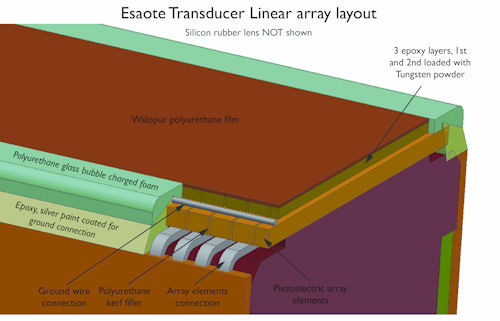 |
| Complex geometry and the use of specialized materials make the design and optimization of an ultrasound transducer a challenge. COMSOL Multiphysics software is capable of handling the elasticity, piezoelectric and dielectric material properties. (Image courtesy COMSOL.) |
Esaote engineers used COMSOL software to model both the general material behavior and the effects of geometry on probe performance such as directivity and beam-steering. The open structure of the software allowed the designers to also integrate the model with an equivalent circuit model. Used together with electric transmission-line matching theory, the multidisciplinary study yielded thickness values for optimized acoustic impedances supporting improved broadband operation.
Kirk Fraser is a design engineer at Roche Ltd. Consulting Group, a Canadian engineering-construction firm. The company’s multidisciplinary teams work on projects ranging from mining and mineral processing to forestry and urban planning, often combining the skills of mechanical, structural, civil and geotechnical specialists. Traditionally, the different disciplines have used quite different software packages (STAAD for structural, Femap for mechanical, etc.) with little crossover between analyses.
However, Fraser’s experience working with LS-DYNA products from Livermore Science Technology Corp. (LSTC) has convinced him that using various capabilities within a single package would produce the best level of validity. CFD analyses, loads and heat transfer could all be done with LS-DYNA, requiring less transfer of information and improving accuracy.
With its upcoming LS-DYNA_R7, LSTC continues its efforts to push costs down and MP capabilities up, adding electromagnetism and compressible/incompressible fluid analyses. The company’s “one-code strategy” tackles multidisciplinary analyses: “to combine the multiphysics capabilities into one scalable code for solving highly non-linear transient problems to enable the solution of coupled multiphysics and multi-stage problems.”
A Shift in Mindset
Other companies whose products support multidisciplinary analysis include Siemens, with its NX TeamCenter collaboration tools, and MSC Software, whose MSC Nastran and Adams solutions work well, for example, with Comet, an integrated modeling and simulation process automation tool from Comet Solutions.
Autodesk’s Williams sums up the benefits of multidisciplinary analysis by observing, “I think it’s very promising that we are actually having a conversation that almost all the time in the past would have been centered around design and CAD. The fact that increased collaboration and data management are now important enough and prevalent enough for simulation, points to the fact that simulation is used a lot more often than it was in the past.”
Contributing Editor Pamela Waterman, DE’s simulation expert, is an electrical engineer and freelance technical writer based in Arizona. You can send her e-mail to [email protected].
More Info
Altair
ANSYS
Autodesk
Bentley
Comet Solutions
COMSOL Multiphysics
Dassault Systèmes
Esaote
Esterel Technologies
Livermore Science Technology Corp.
Mathworks
Mentor Graphics
MSC Software
National Instruments
Roche Ltd. Consulting Group
Siemens
Simulia
Subscribe to our FREE magazine, FREE email newsletters or both!
Latest News
About the Author
Pamela Waterman worked as Digital Engineering’s contributing editor for two decades. Contact her via .(JavaScript must be enabled to view this email address).
Follow DE





